Genetic and molecular backgrounds of the development of glioblastoma
DOI:
https://doi.org/10.18388/pb.2021_495Abstract
Stage IV glioblastoma is the most frequently diagnosed and the worst prognosis tumor of the central nervous system (CNS). Patients suffering from this type of cancer usually survive several months with the use of surgical treatment, radiotherapy and chemotherapy. The development of glioblastoma is determined by a number of mutations, the most common of which are the p16, p19, p53, pRB, PTEN, PDGFR, CDK4 and EGFR protein genes as well as the loss of heterozygosity on chromosomes 10, 17 and 19. The occurrence of mutations within the IDH1 and IDH2 genes and increased methylation of MGMT promoter improves patient survival, but few patients live more than 3 years after diagnosis. The most important cell signaling pathways in glioblastoma are PI3K/Akt/mTOR and Wnt/β-catenin, which play a key role in tumor cell function. However, these cells are highly resistant to anticancer drugs, including inhibitors of cell signaling pathways. Currently, the potential methods of effectively combating malignant gliomas are alternating electric field therapy and the implementation of new immunotherapeutic strategies.

Published
Issue
Section
License
Copyright (c) 2023 Przemysław Panek, Aleksandra Jezela-Stanek

This work is licensed under a Creative Commons Attribution 4.0 International License.
All journal contents are distributed under the Creative Commons Attribution-ShareAlike 4.0 International (CC BY-SA 4.0) license. Everybody may use the content following terms: Attribution — You must give appropriate credit, provide a link to the license, and indicate if changes were made, ShareAlike — If you remix, transform, or build upon the material, you must distribute your contributions under the same license as the original. There are no additional restrictions — You may not apply legal terms or technological measures that legally restrict others from doing anything the license permits.
Copyright for all published papers © stays with the authors.
Copyright for the journal: © Polish Biochemical Society.



